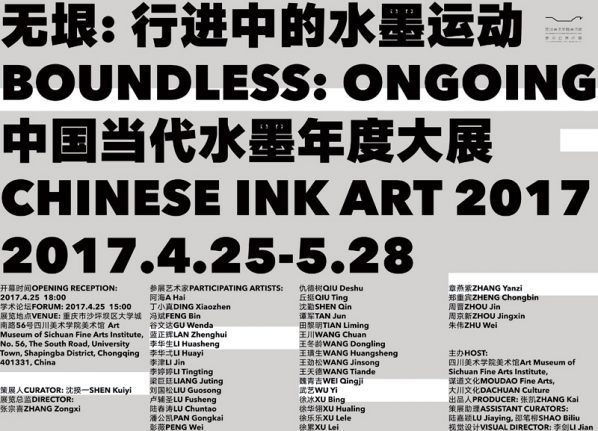
Boundless – Ongoing Chinese Ink Art
By SHEN Kuiyi
How to develop and expand the pictorial and technical language of ink painting has always been a challenge for Chinese artists. Particularly since the beginning of the twentieth century, innovative artists who sought breakthroughs within traditional Chinese ink painting have constantly explored new possibilities. The term “ink art” entered the artistic discourse of mainland China in the 1980s, conceptually differentiating it from the practices and traditions of “Chinese painting” and linking it with the process of “modernization” and “internationalization” then underway. In the particular political and practical context of the time, as China began its process of modernization after decades of isolation, this had its necessity. If the trajectory of art were to be tracked by its synchronic and diachronic coordinates, every moment would have a point in relationship to the horizontal and vertical axes. For a quite long time, artistic developments in China, however, were shielded from necessary and possible latitudinal comparisons with the outside world, and longitudinal comparisons with China’s own history were manipulated or distorted. As a result, from its inception, the concept of “ink art” was faced with pressure on both axes of reference, that is to say, the global and the historical. The internal discursive system of Chinese art was still locked into simplistic binary oppositions that had developed in the framework of early twentieth century debates: tradition vs. modernity, east vs. west, concrete vs. abstract, and national character vs. universality. When Chinese art walked onto the international stage in the 1990s, however, it was fully exposed to potential horizontal comparisons, and as one part of a pluralistic global culture, its cultural identity naturally attracted attention. Contemporary Chinese art inevitably was thrust into this process of constructing a Chinese cultural identity. At the same time, however, in this open conceptual space, transmission and influences across cultures also brought out the practical issues of how to establish a national identity in this pluralistic global culture. Rather than a vehicle for passive expression or a text to be read, Chinese contemporary art is a cultural and economic carrier that is actively engaged in creating history; it is also a process of forming social and subjective identity. After breaking the boundaries of medium and genre, contemporary ink enters a much broader space of artistic expression. The choice of medium and means of expression are never the ultimate goals of art. Ink art, like other forms of art, becomes an important part of the process of constructing cultural consciousness. The thirty-seven artists participating in “Boundless-Ongoing Chinese Ink Art” span three generations. Some, like LIU Guosong, who led the modern ink movement, have been challenging the status quo since the 1950s. A larger group participated in and experienced the entire developmental process of the contemporary experimental ink movement of the 1980s and 1990s. Finally, a younger cohort of practitioners who matured in the digital age bring a new sensibility into their art. The exhibition has organized the development of the contemporary ink movement into five large rather loosely defined, intersecting, and sometimes overlapping categories: Post-Classical, Fantastic, Non-Objective, Secular, and Boundary-Crossing. These works demonstrate the ways Chinese ink artists are freely, within the broad discourse of contemporary art, using the vocabulary of ink to reinterpret classical ink painting, convey their perceptions of the external world, express their concern for human life, and manifest their spiritual pursuits. Artists in the “Post-Classical” section establish a linkage between traditional standards of value and modern aesthetics and modes of artistic appreciation. All reinterpret the self-cultivation and spirit of literati culture and even the value system attached to the basic language of brush and ink. “Fantastic” artists convey their individual social, cultural, and historical memories and consciousness to their artworks with absurd, humorous, symbolic, or illusionary images, adopting virtual or metaphorical fantasy worlds to present their perceptions and beliefs. The “Non-Objective” section displays the explorations of Chinese artists in the field of abstract painting. Regardless of whether they refine the abstract elements of Chinese traditional painting and calligraphy or appropriate concepts of Western abstract art, they use ink to create their new interpretation of abstraction. The artworks in the “Secular” section are more directly related to contemporary society and life, with a temporal attitude, expressing their concerns about human life, the human body, and human desire, as well as strong criticism of the various phenomena of contemporary society. The artists in the “Boundary-Crossing” section fully demonstrate the creative pluralism of ink art. They challenge tradition from multiple angles, including conception, formal language, and materials, thereby expanding and developing the formal language of ink art. Of course, the artworks shown in this exhibition do not represent all of the important trends in contemporary ink art. They each use a unique way of questioning tradition or modernity, and regardless of whether conceptual or representational, they all embody the contemporaneity of society and culture and demonstrate the boundless potential of ink art.About the exhibition
Boundless: Ongoing – Chinese Ink Art 2017 Curator: SHEN Kuiyi Director: ZHANG Zongxi Duration: 2017.4.25 – 5.28 Opening Reception: 2017.4.25 18:00 Forum: 2017.4.25 15:00 Venue: The Art Museum of Sichuan Fine Arts Institute Address: No. 56, The South Road, University Town, Shapingba District, Chongqing 401331, China Participating Artists: A Hai, DING Xiaozhen, FENG Bin, GU Wenda, LAN Zhenghui, LI Huasheng, LI Huayi, LI Jin, LI Tingting, LIANG Juting, LIU Guosong, LU Fusheng, LU Chuntao, PAN Gongkai, PENG Wei, QIU Deshu, QIU Ting, SHI Jiazhuang, TAN Jun, TIAN Liming, WANG Chuan, WANG Dongling, WANG Huangsheng, WANG Jinsong, WANG Tiande, WEI Qingji, WU Yi, XU Bing, XU Hualing, XU Lele, XU Lei, ZHANG Yanzi, ZHENG Chongbin, ZHOU Jin, ZHOU Jingxin, ZHU Wei Host: Art Museum of Sichuan Fine Arts Institute, MOUDAO Fine Arts, DACHUAN Culture Producer: ZHANG Kai Assistant Curators: LU Jiaying, SHAO Biliu Visual Director: LI JianCourtesy of The Art Museum of Sichuan Fine Arts Institute.




























